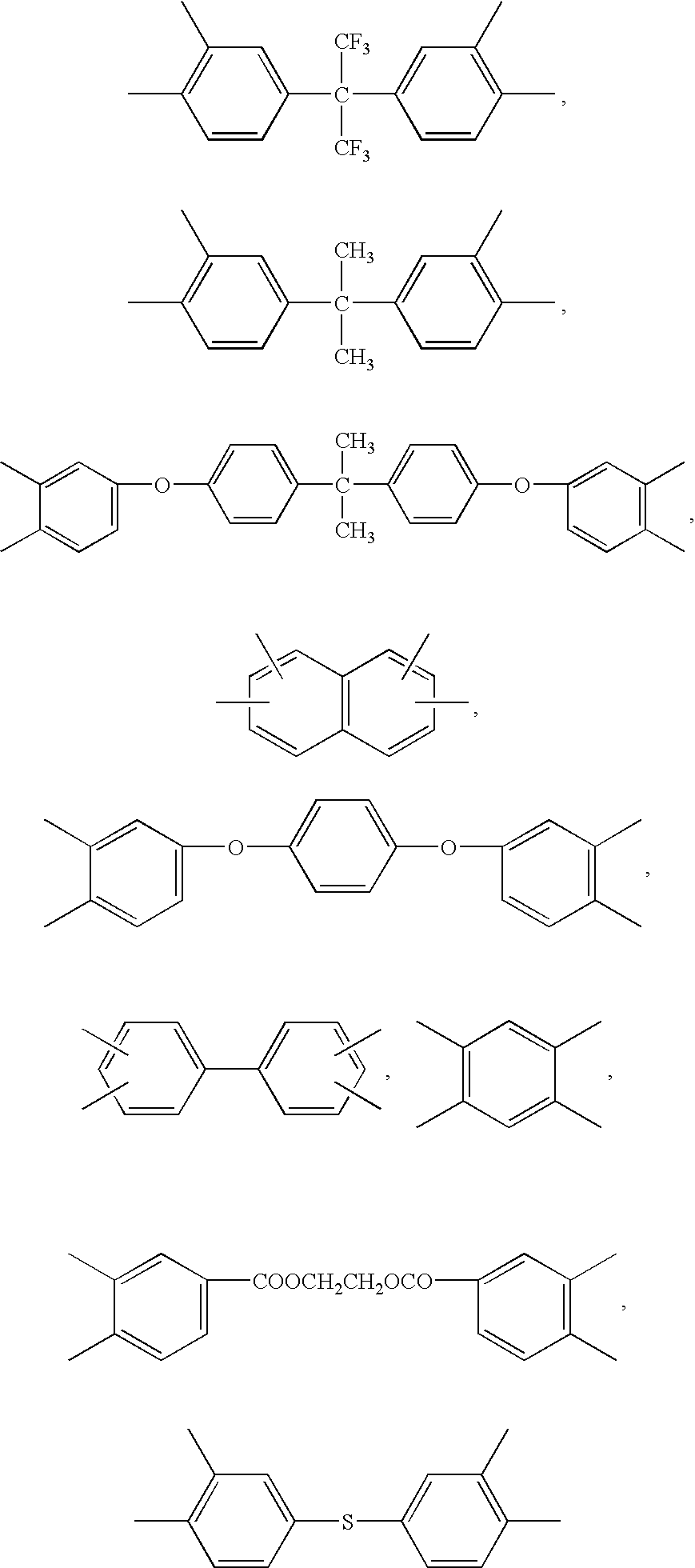Polymer Membranes Derived from Aromatic Polyimide Membranes
- Summary
- Abstract
- Description
- Claims
- Application Information
AI Technical Summary
Benefits of technology
Problems solved by technology
Method used
Image
Examples
example 1
Synthesis of poly(BTDA-APAF-HAB) polyimide
[0049]An aromatic poly[3,3′,4,4′-benzophenonetetracarboxylic dianhydride-2,2-bis(3-amino-4-hydroxyphenyl)-hexafluoropropane-3,3′-dihydroxy-4,4′-diamino-biphenyl] (poly(BTDA-APAF-HAB)) polyimide containing UV cross-linkable carbonyl groups and pendent —OH functional groups ortho to the heterocyclic imide nitrogen in the polymer backbone was synthesized from 2,2-bis(3-amino-4-hydroxyphenyl)-hexafluoropropane diamine (BTDA), 3,3′,4,4′-benzophenonetetracarboxylic dianhydride (APAF), and 3,3′-dihydroxy-4,4′-diamino-biphenyl (HAB) in NMP polar solvent by a two-step process involving the formation of the poly(amic acid) followed by a solution imidization process. Acetic anhydride was used as the dehydrating agent and pyridine was used as the imidization catalyst for the solution imidization reaction. For example, a 250 mL three-neck round-bottom flask equipped with a nitrogen inlet and a mechanical stirrer was charged with 13.3 g of APAF, 3.94 g of...
example 2
Preparation of poly(BTDA-APAF-HAB) polyimide polymer membrane
[0050]The poly(BTDA-APAF-HAB) polyimide polymer membrane was prepared as follows: 4.0 g of poly(BTDA-APAF-HAB) polyimide synthesized in Example 1 was dissolved in a solvent mixture of 12.0 g of NMP and 12.0 g of 1,3-dioxolane. The mixture was mechanically stirred for 2 h to form a homogeneous casting dope. The resulting homogeneous casting dope was allowed to degas overnight. The poly(BTDA-APAF-HAB) polymer membrane was prepared from the bubble free casting dope on a clean glass plate using a doctor knife with a 20-mil gap. The membrane together with the glass plate was then put into a vacuum oven. The solvents were removed by slowly increasing the vacuum and the temperature of the vacuum oven. Finally, the membrane was dried at 200° C. under vacuum for at least 48 hours to completely remove the residual solvents to form poly(BTDA-APAF-HAB) polymer membrane (abbreviated as BTDA-APAF-HAB).
example 3
Preparation of new polymer membrane from BTDA-APAF-HAB membrane by UV crosslinking and thermal treatment
[0051]The BTDA-APAF-HAB membrane prepared in Example 2 was exposed to UV radiation using 254 nm wavelength UV light generated from a UV lamp with 1.9 cm (0.75 inch) distance from the membrane surface to the UV lamp and a radiation time of 20 minutes at 50° C. The UV lamp that was used was a low pressure, mercury arc immersion UV quartz 12 watt lamp with 12 watt power supply from Ace Glass Incorporated. The UV crosslinked BTDA-APAF-HAB membrane was then thermally heated from 50° to 450° C. at a heating rate of 3° C. / min under N2 flow. The membrane was hold for 1 hour at 450° C. and then cooled down to 50° C. at a heating rate of 3° C. / min under N2 flow. The UV crosslinked and then heat-treated new membrane was abbreviated as BTDA-APAF-HAB-UV-HT.
PUM
| Property | Measurement | Unit |
|---|---|---|
| Temperature | aaaaa | aaaaa |
| Angle | aaaaa | aaaaa |
| Temperature | aaaaa | aaaaa |
Abstract
Description
Claims
Application Information
 Login to View More
Login to View More - R&D
- Intellectual Property
- Life Sciences
- Materials
- Tech Scout
- Unparalleled Data Quality
- Higher Quality Content
- 60% Fewer Hallucinations
Browse by: Latest US Patents, China's latest patents, Technical Efficacy Thesaurus, Application Domain, Technology Topic, Popular Technical Reports.
© 2025 PatSnap. All rights reserved.Legal|Privacy policy|Modern Slavery Act Transparency Statement|Sitemap|About US| Contact US: help@patsnap.com



